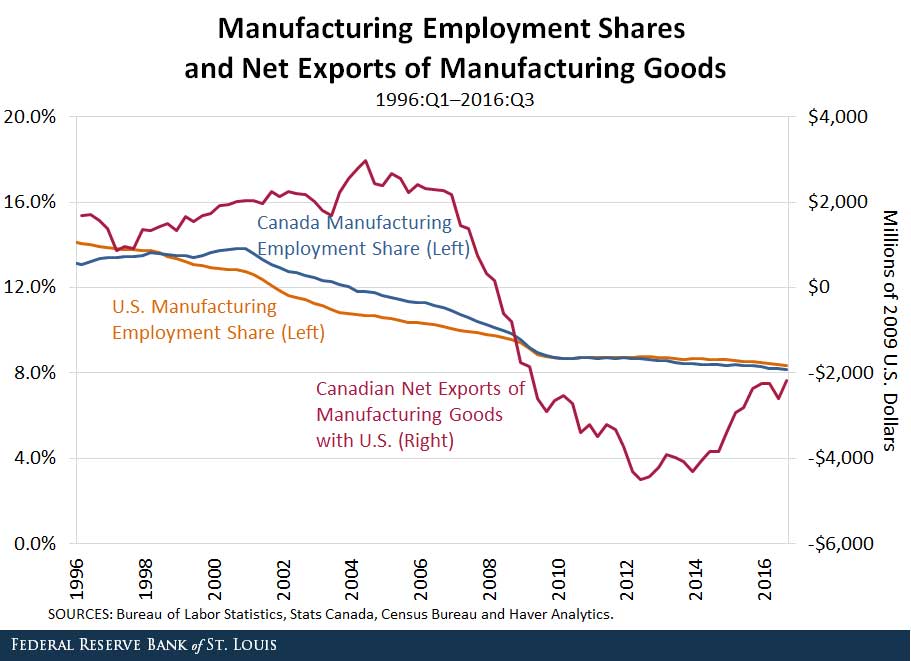How Do Imports Affect Manufacturing Jobs?

One popular opinion is that competition from imports has decreased employment in the U.S. manufacturing sector. While manufacturing employment has declined as net exports have fallen, the data imply that trade is not the main cause. For example, a study by Michael Hicks and Srikant Devaraj reported that a negative trade deficit accounted for only about 13 percent of jobs lost in the sector.1
The U.S.’s counterparts in the Group of Seven2 have experienced a comparable secular decline in the share of total employment devoted to manufacturing. The Canadian experience, in particular, has been very similar to that of the U.S.
As seen in the figure below, the employment share in manufacturing in both the U.S. and Canada fell roughly in tandem from about 15 percent in 1996 to about 8 percent in 2016.

Just like in the U.S., the common view from the Canadian perspective is that the decline is due to increased foreign competition. Over the above sample period, more than 60 percent of Canadian trade in manufactures is with the U.S. If foreign competition is responsible for the decline in Canadian manufacturing employment, a telltale sign would be a decline in Canadian net exports of manufactures to the U.S.
The figure shows that Canadian net exports of manufactures to the U.S. was in fact increasing in the first half of the sample period. This happened even as the manufacturing employment share declined in both countries. In 2008, the Canadian trade balance in manufactured goods with the U.S. went from surplus to deficit. And yet, the manufacturing employment share seems to have stabilized in both countries.
This type of evidence illustrates the difficulties in squaring popular opinion with the data. If international trade flows were the dominant factor in explaining U.S. manufacturing employment, one would expect to see a strong correlation between sectoral trade balances and sectoral employment. The data suggest that this correlation is absent.
Notes and References
1 Hicks, Michael J.; and Devaraj, Srikant. “The Myth and the Reality of Manufacturing in America.” Ball State University Center for Business and Economic Research, 2015.
2 The Group of Seven consists of Canada, France, Germany, Italy, Japan, the United Kingdom and the U.S.
Additional Resources
- On the Economy: How Does Terrorism Affect Trade?
- On the Economy: China’s Currency and Net International Income Flow
- On the Economy: Dissecting the Falling Labor Force Participation Rate
Citation
David Andolfatto and Andrew Spewak, ldquoHow Do Imports Affect Manufacturing Jobs?,rdquo St. Louis Fed On the Economy, Jan. 10, 2017.
This blog offers commentary, analysis and data from our economists and experts. Views expressed are not necessarily those of the St. Louis Fed or Federal Reserve System.
Email Us
All other blog-related questions



